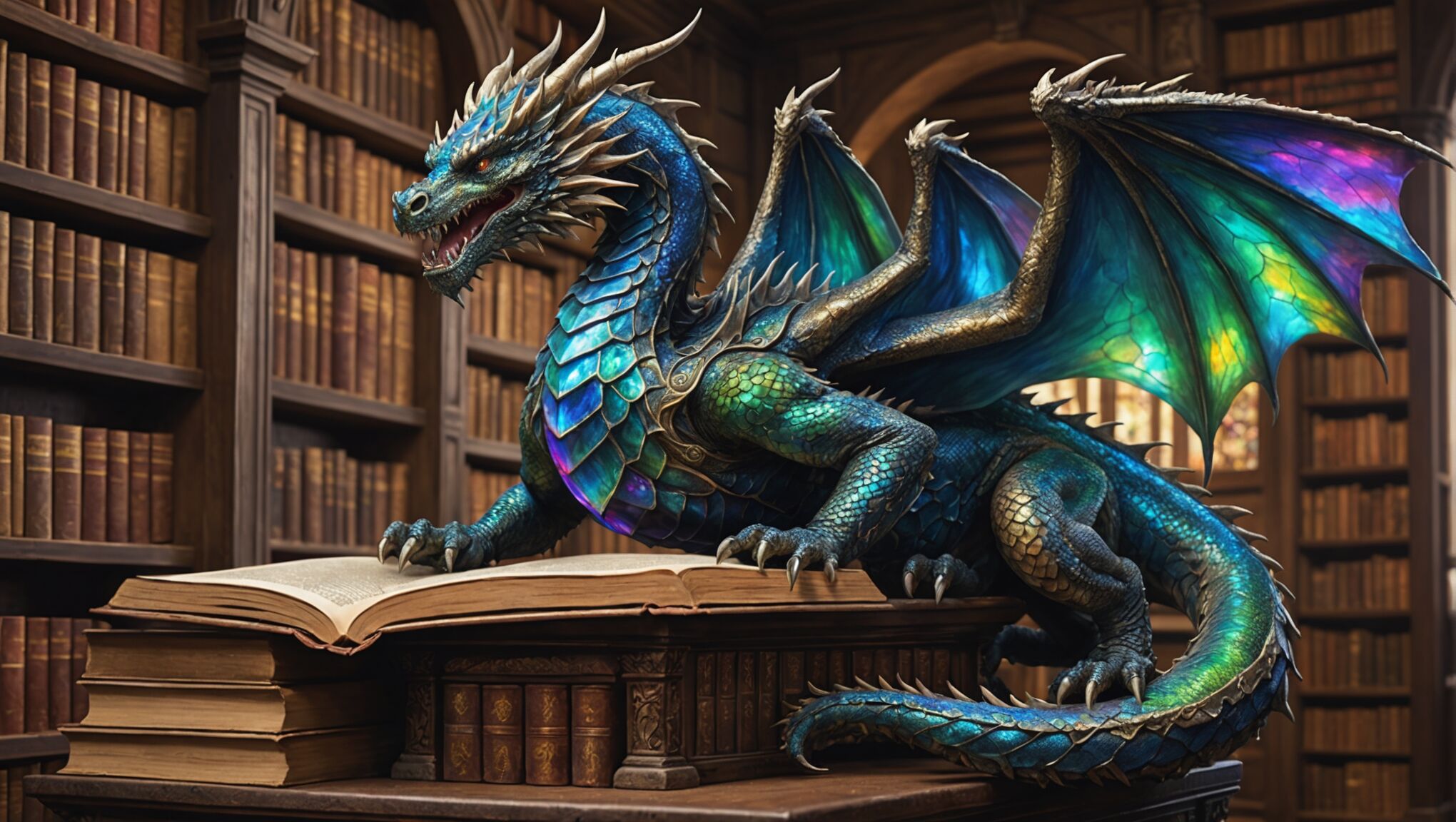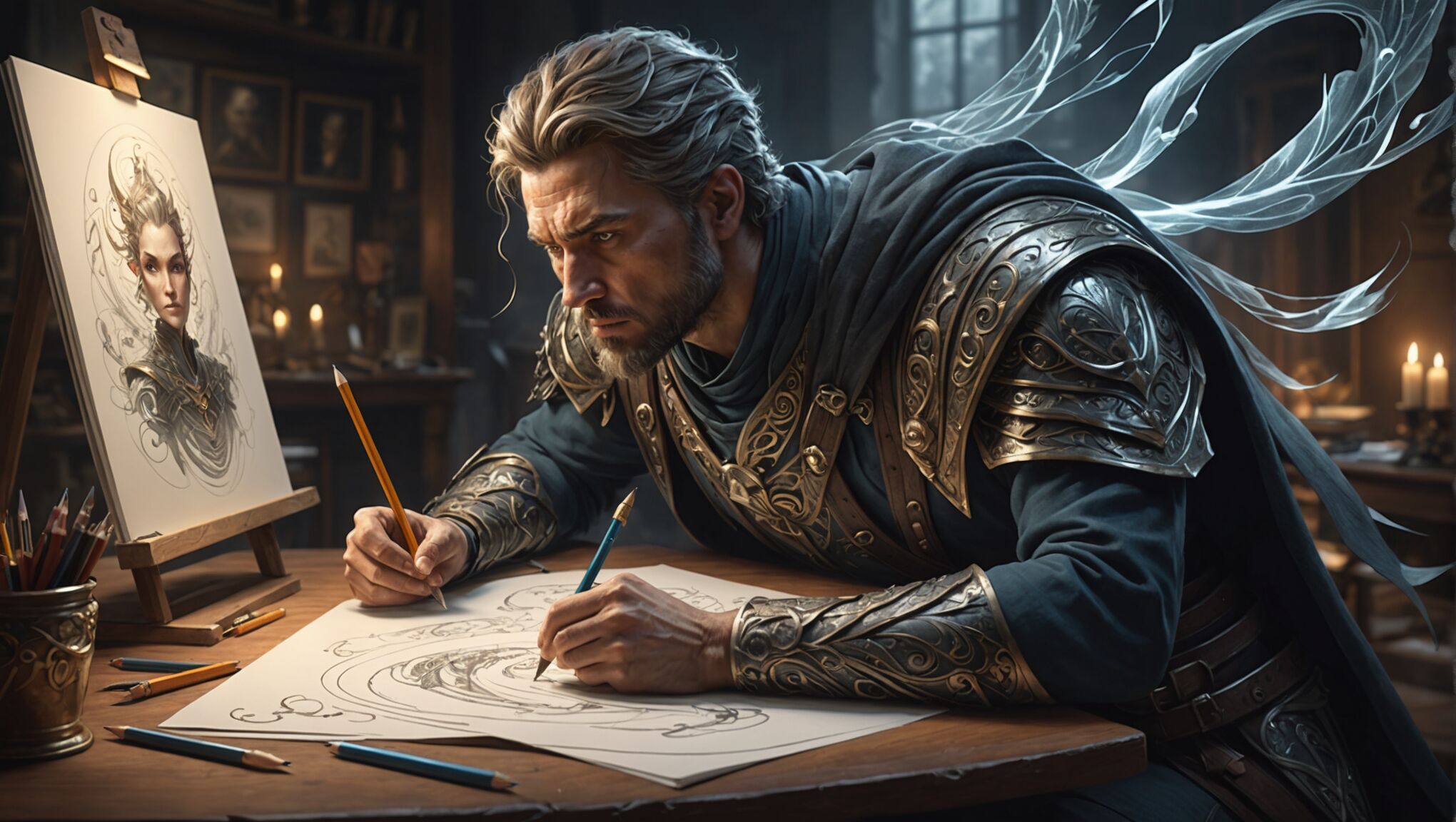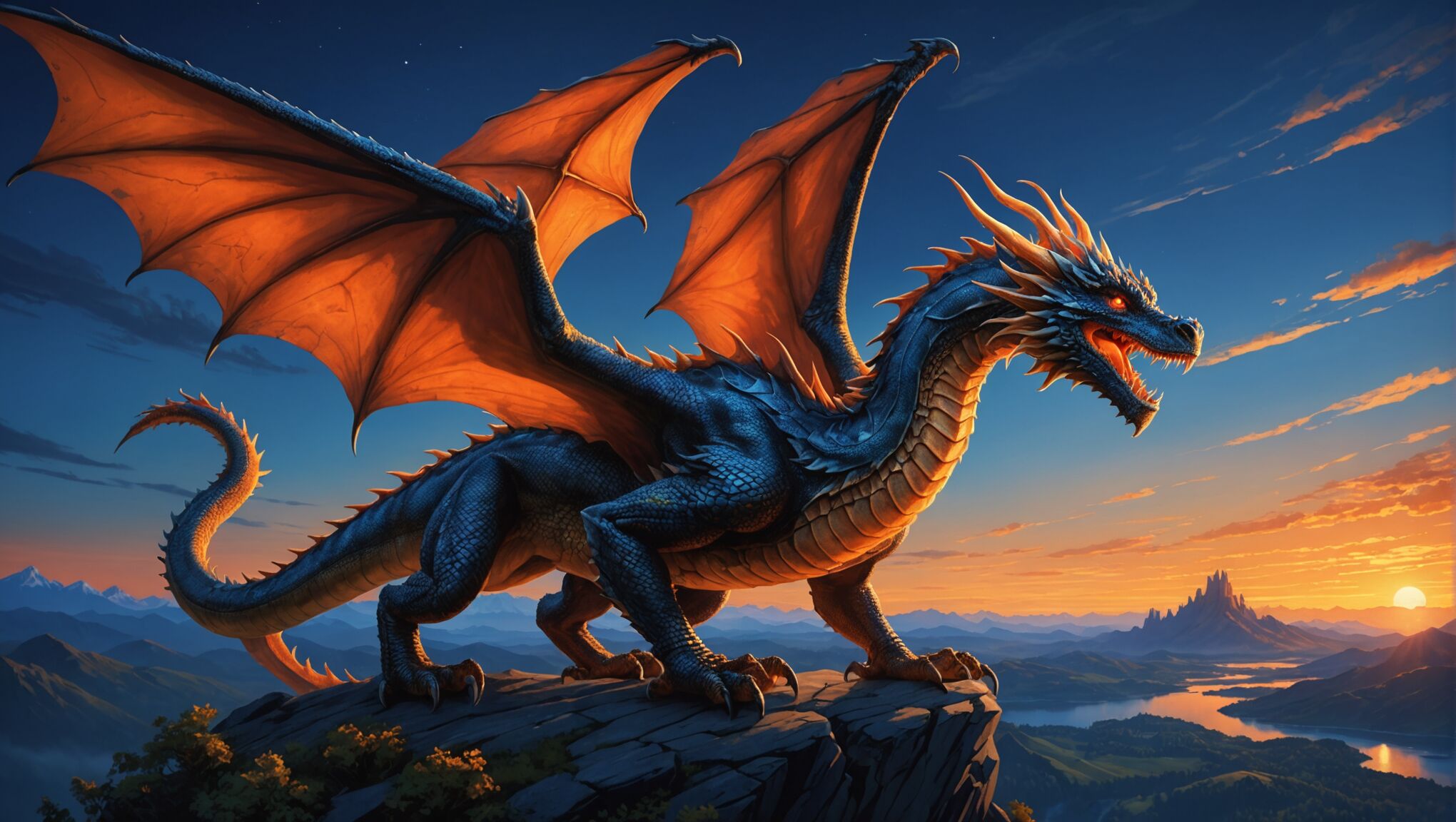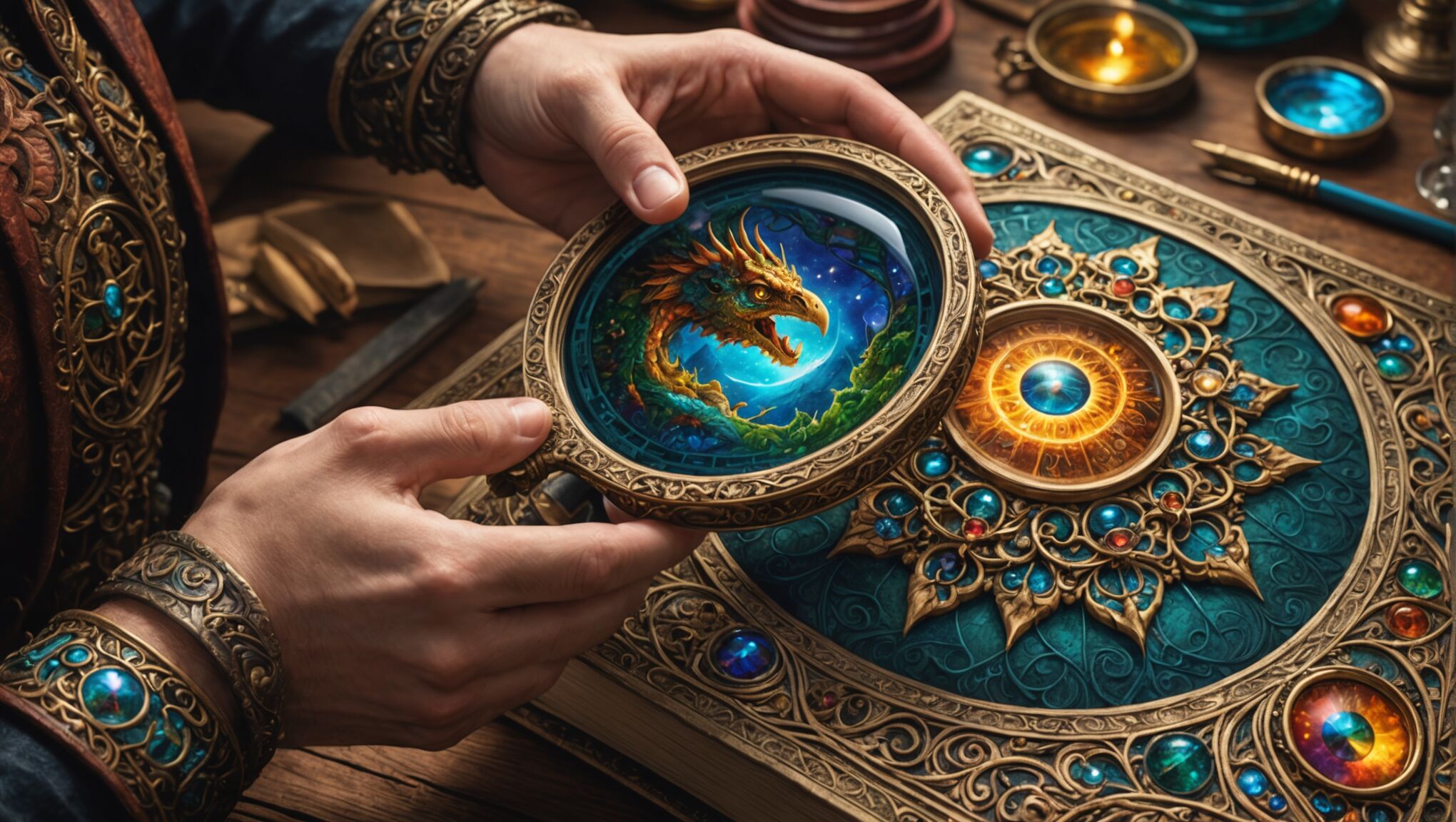blog
From Concept to Cover: Designing Epic Fantasy Artwork
Epic fantasy artwork transports viewers to realms of magic, mythical creatures, and heroic quests. To create captivating visuals, artists must immerse themselves in the genre’s rich tapestry of storytelling traditions. “Fantasy is the impossible made probable,” as Rod Serling once said, and this principle guides the creation of compelling fantasy art. Artists should familiarize themselves with classic fantasy literature, from J.R.R. Tolkien’s Middle-earth to George R.R. Martin’s Westeros, to grasp the genre’s core elements. These often include elaborate world-building, intricate magic systems, and complex character dynamics. Understanding the tropes and archetypes common in fantasy—such as the reluctant hero, the wise mentor, or the dark lord—allows artists to play with or subvert these expectations in their work. Additionally, exploring various sub-genres within fantasy, like high fantasy, dark fantasy, or urban fantasy, can broaden an artist’s creative palette. Studying the visual language of fantasy across different media, including films, video games, and tabletop role-playing games, provides insight into how fantastical concepts are translated into visual form. Artists should also consider the cultural influences that shape fantasy narratives, drawing inspiration from diverse mythologies and folklore worldwide. By delving deep into the genre’s foundations, artists can create artwork that not only captures the essence of fantasy but also pushes its boundaries, inviting viewers to explore new realms of imagination.
Research and inspiration
 To create truly captivating fantasy artwork, artists must cast a wide net for inspiration and conduct thorough research. This process involves delving into various sources, both within and outside the fantasy genre, to enrich the visual storytelling and bring authenticity to imaginary worlds.
To create truly captivating fantasy artwork, artists must cast a wide net for inspiration and conduct thorough research. This process involves delving into various sources, both within and outside the fantasy genre, to enrich the visual storytelling and bring authenticity to imaginary worlds.
One crucial aspect of research is studying historical art and architecture. Medieval and Renaissance paintings, for instance, can provide insights into period-appropriate clothing, armor, and weaponry. Ancient civilizations like Egypt, Greece, and Rome offer a wealth of inspiration for grand structures and intricate designs. Artists should also explore non-Western cultures, such as the ornate patterns of Islamic art or the dynamic compositions of Japanese ukiyo-e prints, to infuse their work with unique elements.
Nature serves as another invaluable source of inspiration. Observing the diverse forms of plants and animals can spark ideas for fantastical creatures and otherworldly landscapes. Geological formations, weather phenomena, and celestial bodies can all contribute to the creation of awe-inspiring fantasy environments.
“The artist is a receptacle for emotions that come from all over the place: from the sky, from the earth, from a scrap of paper, from a passing shape, from a spider’s web.” – Pablo Picasso
This quote emphasizes the importance of drawing inspiration from a variety of sources, even those that may seem unrelated at first glance.
Artists should also immerse themselves in the works of renowned fantasy illustrators. Studying the techniques and styles of artists like Frank Frazetta, Boris Vallejo, or John Howe can provide valuable insights into effective composition, dramatic lighting, and character design. However, it’s crucial to use these influences as a starting point rather than simply imitating them.
Research extends to the specific project at hand as well. If designing a book cover, artists should thoroughly read the manuscript or a detailed synopsis to understand the story’s themes, characters, and key scenes. Collaborating closely with authors and publishers ensures that the artwork accurately represents the narrative and resonates with the target audience.
Additionally, exploring scientific concepts can lend credibility to fantastical elements. Understanding basic principles of physics, biology, and astronomy can help artists create more believable magical systems and alternate realities. For example, knowledge of animal anatomy can inform the design of believable mythical creatures.
Collecting reference materials is an essential part of the research process. This may include photographs, sketches, textures, and color palettes. Creating a mood board or digital collection of inspirational images can help artists visualize the overall aesthetic they want to achieve.
Lastly, artists should not underestimate the value of personal experiences and emotions. Channeling one’s own feelings, memories, and dreams into the artwork can imbue it with a unique and authentic quality that resonates with viewers on a deeper level.
By conducting thorough research and drawing inspiration from a diverse array of sources, fantasy artists can create rich, immersive visuals that transport viewers to extraordinary worlds and bring epic stories to life.
Conceptualizing the artwork

Once the groundwork of research and inspiration is laid, the next crucial step is conceptualizing the artwork. This phase involves transforming abstract ideas and literary descriptions into concrete visual elements. Artists begin by sketching rough thumbnails, exploring various compositions and arrangements of characters, creatures, and environments. These initial sketches serve as a brainstorming tool, allowing for quick iteration and experimentation with different concepts.
During this stage, artists focus on capturing the essence of the story or scene they wish to depict. They consider key questions: What is the central conflict or moment being illustrated? Which characters or elements are most important to showcase? How can the mood and atmosphere of the narrative be conveyed visually? These considerations guide the development of the artwork’s core concept.
Pick color combinations that captivate. Get the facts.
Character design plays a vital role in fantasy artwork conceptualization. Artists must breathe life into protagonists, antagonists, and supporting characters, ensuring that their appearances reflect their personalities, roles, and the world they inhabit. This process involves designing distinctive features, appropriate clothing, and meaningful accessories or weapons that align with the character’s backstory and the overall aesthetic of the fantasy world.
World-building is another critical aspect of conceptualization. Artists must visualize and create environments that are both fantastical and believable. This might include designing unique architecture, imagining otherworldly landscapes, or conceptualizing magical phenomena. The goal is to create a setting that enhances the narrative and immerses the viewer in the fantasy realm.
As concepts take shape, artists begin to refine their ideas through more detailed sketches and studies. They may create multiple versions of key elements, experimenting with different poses, expressions, or environmental details. This iterative process allows for the exploration of various artistic directions before committing to a final concept.
Throughout conceptualization, maintaining a balance between creativity and practicality is essential. While pushing the boundaries of imagination, artists must also consider the technical aspects of execution, such as the medium they will use and any constraints imposed by the project brief or publication format.
Collaboration often plays a significant role in this phase, especially for commissioned work. Artists may engage in discussions with authors, art directors, or publishers to ensure that their concepts align with the vision for the project. This dialogue can lead to valuable insights and refinements that strengthen the overall concept.
As the conceptualization phase progresses, artists gradually move from broad ideas to more specific visual solutions. They begin to consider lighting, perspective, and the overall mood that will best convey the intended narrative. This transition sets the stage for the more detailed work to come, laying a strong foundation for the creation of compelling fantasy artwork.
Composition and focal points
When designing fantasy artwork, composition and focal points play crucial roles in guiding the viewer’s eye and conveying the essence of the story. A well-crafted composition can create a sense of drama, tension, or wonder, while strategically placed focal points ensure that key elements of the artwork capture the viewer’s attention.
One fundamental principle in composing fantasy artwork is the rule of thirds. By dividing the canvas into a 3×3 grid, artists can place important elements along these lines or at their intersections to create a balanced and visually appealing composition. This technique helps avoid centering subjects, which can often result in static or less engaging images.
Leading lines are another powerful tool in fantasy art composition. These can be created through elements such as character poses, weapon angles, architectural features, or landscape contours. By carefully directing these lines, artists can guide the viewer’s gaze through the image, creating a sense of movement and depth.
Depth and perspective play crucial roles in immersing viewers in fantastical worlds. Utilizing foreground, middle ground, and background elements can create a sense of scale and grandeur often associated with epic fantasy. Overlapping objects, varying levels of detail, and atmospheric perspective can further enhance the illusion of depth.
When it comes to focal points, contrast is key. This can be achieved through various means:
| Contrast Type | Description |
| Value contrast | Using light and dark areas to draw attention |
| Color contrast | Employing complementary or vibrant colors against muted backgrounds |
| Size contrast | Juxtaposing large and small elements to create emphasis |
| Textural contrast | Varying surface qualities to direct focus |
Artists often use a hierarchy of focal points to tell a visual story. The primary focal point typically showcases the main subject or action, while secondary focal points provide supporting details or context. This hierarchy can be established through size, placement, level of detail, or contrast.
Negative space is an often-overlooked but powerful compositional tool in fantasy art. By strategically incorporating areas of emptiness or simplicity, artists can create balance, emphasize key elements, and evoke a sense of mystery or vastness.
Dynamic compositions can be achieved through diagonal lines, asymmetry, and the use of triangular or S-shaped arrangements. These techniques can infuse energy and movement into the artwork, reflecting the epic nature of many fantasy narratives.
When designing book covers or promotional art, it’s crucial to consider the placement of text elements. Leaving appropriate space for titles, author names, and other textual information ensures that the composition remains effective even with these additions.
Framing devices, such as archways, tree branches, or magical portals, can be used to direct focus and create a sense of depth. These elements can also help transition the viewer from the real world into the fantastical realm depicted in the artwork.
Artists should also consider the emotional impact of their compositional choices. For instance, placing a character high in the frame can convey power or triumph, while positioning them lower might suggest vulnerability or defeat. The use of open or closed compositions can affect the viewer’s sense of involvement in the scene.
Iterative sketching and thumbnail studies are invaluable for exploring various compositional options. By quickly generating multiple layouts, artists can experiment with different arrangements and focal points before committing to a final design.
Ultimately, the goal of composition and focal point placement in fantasy artwork is to create a visually compelling image that not only captures the imagination but also effectively communicates the story or concept behind the piece. By mastering these principles, artists can create artwork that draws viewers into fantastical worlds and leaves a lasting impression.
Color theory and mood
 Color theory and mood are fundamental aspects of creating impactful fantasy artwork. The choice of color palette can dramatically influence the viewer’s emotional response and set the tone for the entire piece. Artists must carefully consider how different hues, saturations, and values interact to create a cohesive and evocative visual experience.
Color theory and mood are fundamental aspects of creating impactful fantasy artwork. The choice of color palette can dramatically influence the viewer’s emotional response and set the tone for the entire piece. Artists must carefully consider how different hues, saturations, and values interact to create a cohesive and evocative visual experience.
One of the most powerful tools in an artist’s arsenal is the use of color temperature. Warm colors like reds, oranges, and yellows can evoke feelings of energy, passion, and danger. Cool colors such as blues, greens, and purples often convey calmness, mystery, or melancholy. By manipulating the balance between warm and cool tones, artists can create tension or harmony within their compositions.
Complementary color schemes, which use colors opposite each other on the color wheel, can create vibrant contrasts that draw the eye and energize a scene. For example, pairing a fiery orange dragon against a deep blue sky can create a striking visual impact. Analogous color schemes, using colors adjacent on the color wheel, can create a sense of harmony and unity, perfect for depicting serene magical forests or ethereal realms.
The saturation of colors plays a crucial role in setting the mood. Highly saturated colors can convey intensity, magic, and otherworldliness, while desaturated or muted tones might suggest a more grounded, gritty, or historical fantasy setting. Artists can use selective saturation to guide the viewer’s focus, making key elements pop against a more subdued background.
Value contrast is essential for creating depth and atmosphere in fantasy artwork. Dark shadows can add mystery and drama, while bright highlights can suggest hope or divine intervention. The careful manipulation of light and shadow can transform a flat image into a dynamic, three-dimensional scene that pulls the viewer into the fantasy world.
Color symbolism is another powerful tool, especially in fantasy contexts where colors might have specific magical or cultural significance. For instance, gold might represent divinity or wealth, while green could symbolize nature magic or poison, depending on the context.
Artists should also consider the psychological effects of different colors. Red can increase heart rate and create a sense of urgency, making it ideal for battle scenes. Blue can have a calming effect, suitable for depicting serene magical lakes or wise wizards. Purple, often associated with royalty and mysticism, can add an air of elegance and mystery to fantasy characters or settings.
The use of color gradients and atmospheric perspective can enhance the sense of depth and scale in fantasy landscapes. As objects recede into the distance, they typically become cooler in temperature, less saturated, and lighter in value, mimicking the effect of atmospheric haze.
Lighting plays a crucial role in both color application and mood setting. The color of light sources in a fantasy scene can dramatically alter the overall palette. For example, the warm glow of firelight will cast different hues compared to the cool radiance of moonlight or the ethereal gleam of magical energy.
Artists can also use color to create visual hierarchy, guiding the viewer’s eye through the composition. Brighter, more saturated colors naturally draw attention and can be used to highlight important elements or characters in the scene.
Experimenting with limited color palettes can lead to striking and memorable fantasy artwork. By restricting the range of colors used, artists can create a unique visual style that sets their work apart and enhances the mood of the piece.
As you delve deeper into color theory and its application in fantasy art, consider how different color combinations make you feel. What emotions or associations do they evoke? How might these change in different cultural contexts? Exploring these questions can lead to more nuanced and effective use of color in your artwork.
Remember that the interplay between color and light is an endless source of experimentation and discovery. As you develop your skills, don’t be afraid to push boundaries and create unexpected color combinations that challenge traditional fantasy aesthetics. The most memorable fantasy artworks often come from artists who find new ways to use color to transport viewers to extraordinary worlds.
Finalizing and preparing for print

As the artwork nears completion, artists must shift their focus to the final stages of refinement and preparation for print. This process involves a meticulous review of every element to ensure the highest quality output. One crucial step is color correction and calibration. Artists must account for the differences between screen displays and print reproduction, adjusting colors to maintain their intended vibrancy and mood when transferred to physical media.
Attention to detail becomes paramount during this phase. Artists scrutinize their work at high magnification, refining intricate textures, sharpening edges, and enhancing subtle gradients. They may also add final touches such as highlights, deeper shadows, or atmospheric effects to elevate the overall impact of the piece.
File preparation is a critical aspect of finalizing artwork for print. This includes ensuring the correct color mode (typically CMYK for print), appropriate resolution (usually 300 DPI or higher), and proper file format (often TIFF or high-quality PDF). Artists must also consider the bleed area, extending elements beyond the trim line to avoid white edges in the final print.
For book covers or promotional materials, artists collaborate closely with designers to accommodate text placement. This may involve creating variations of the artwork with different element arrangements or providing layered files to allow for flexibility in text integration.
Proofing is an essential step in the finalization process. Artists often request test prints to assess color accuracy, detail reproduction, and overall print quality. This allows for adjustments before the final production run, ensuring the printed artwork closely matches the digital original.
Copyright and licensing considerations come into play during this stage. Artists should ensure proper documentation of their work, including signatures or watermarks where appropriate, and clarify usage rights with clients or publishers.
As technology evolves, artists may also need to prepare their artwork for digital distribution. This could involve creating alternate versions optimized for web display or e-book formats, considering how the image will appear on various devices and screen sizes.
Throughout the finalization process, maintaining open communication with printers, publishers, and art directors is crucial. This collaboration helps address any technical issues, ensures adherence to project specifications, and allows for last-minute refinements based on stakeholder feedback.
By meticulously attending to these final steps, artists can ensure that their epic fantasy artwork translates effectively from concept to cover, captivating audiences and bringing imaginary worlds to vibrant life in print and digital media alike.

